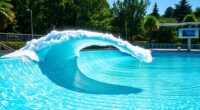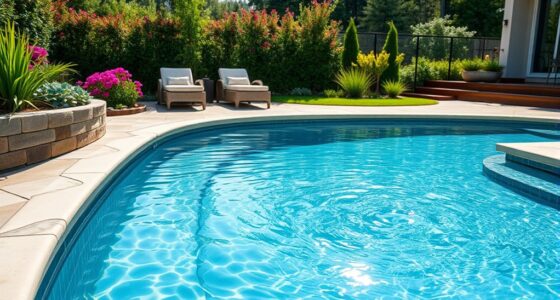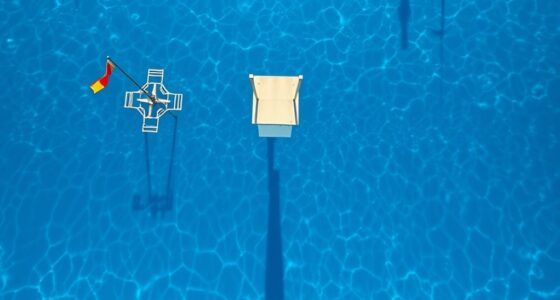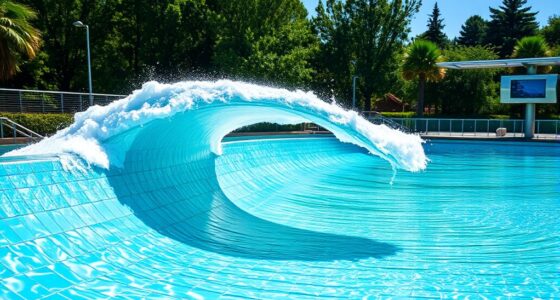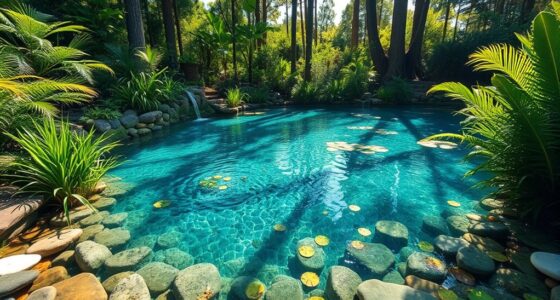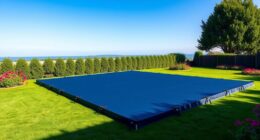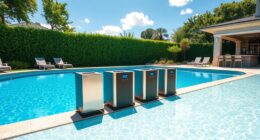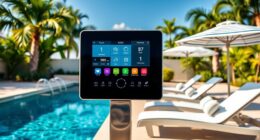Lazy river pools work thanks to a hidden system of pumps, flow channels, and safety features that keep the water moving smoothly and effortlessly. Pumps circulate water continuously, while carefully designed curves and slight slopes guide it safely along. Advanced filtration guarantees clean, clear water, and valves control speed and direction. Together, these elements create a seamless drift experience. Keep exploring to uncover the fascinating mechanics behind this relaxing aquatic ride.
Key Takeaways
- Pumps circulate water continuously, maintaining steady flow and preventing stagnation in the lazy river.
- Carefully designed flow channels with gentle curves ensure smooth navigation and reduce turbulence.
- Water flow dynamics, including pressure and turbulence control, create a uniform drift experience.
- Proper gradient and slope design help guide water efficiently while ensuring swimmer safety.
- Regular filtration and water quality maintenance keep the water clean, safe, and inviting for guests.
The Role of Pumps in Maintaining Flow

Have you ever wondered how lazy rivers keep their water flowing smoothly? It all comes down to the powerful pumps working behind the scenes. These pumps continuously circulate water, ensuring it doesn’t stagnate or become murky. They pull water from the river and push it back into the system, creating a steady flow. This constant movement keeps debris, algae, and bacteria from building up, maintaining clean, clear water. Pumps are usually installed at strategic points along the river, often hidden beneath the surface or within surrounding structures. Their capacity and speed can be adjusted to control the flow’s strength, making sure the drift remains gentle yet consistent. Proper wall organization can also help optimize the space around the pumps for maintenance and operation. Without these essential devices, the lazy river would quickly lose its appeal, becoming stagnant and uninviting.
Designing the Flow Channels for Smooth Navigation
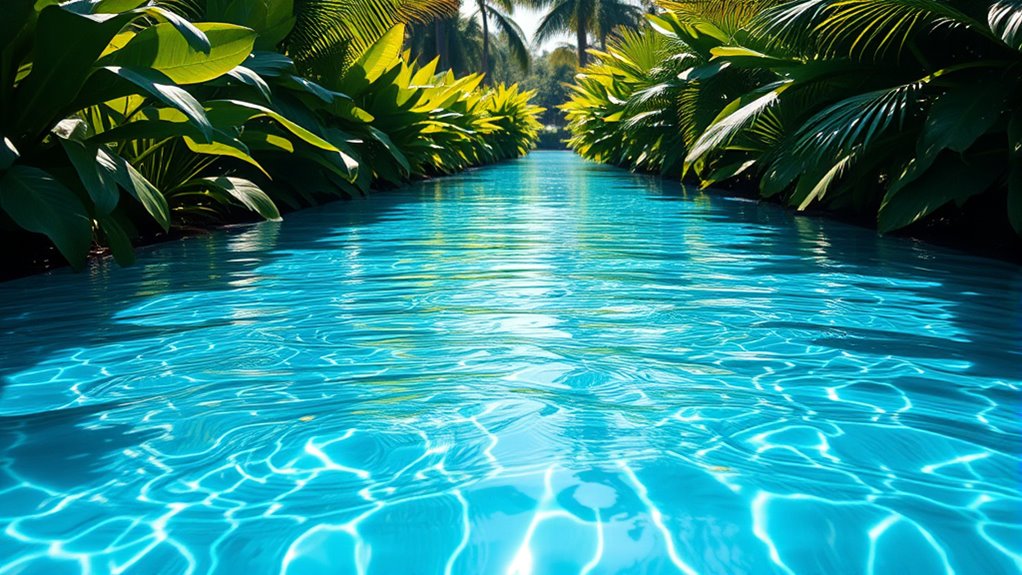
To guarantee smooth navigation, you need to optimize the channel shape for consistent water flow. Pay attention to how the flow dynamics change with different designs, and adjust the gradient and slope to guide riders effortlessly. Properly balancing these elements creates a seamless and enjoyable lazy river experience. Consulting Hours Today List resources can help coordinate maintenance around peak usage times, ensuring the flow remains uninterrupted.
Channel Shape Optimization
Designing flow channels with ideal shapes is essential for guaranteeing smooth navigation throughout the lazy river. You want to create curves that guide water evenly, avoiding sharp turns or abrupt changes that could disrupt the flow. Gentle, sweeping bends help maintain a steady current, reducing turbulence and minimizing obstacles for swimmers. Wider sections allow water to accelerate naturally, while narrowing points increase flow speed where needed. Using consistent, smooth curves minimizes areas where water might stagnate or whirl, which can cause discomfort or safety issues. When you optimize the channel shape, you ensure a gentle, consistent drift for swimmers, making the experience enjoyable and effortless. Proper design also helps in efficient water circulation, reducing maintenance needs and enhancing overall pool performance.
Water Flow Dynamics
Achieving smooth navigation in a lazy river depends on carefully controlling how water flows through the channels. Proper flow dynamics ensure a steady, gentle current that guides swimmers effortlessly. To take into account factors like flow rate, turbulence, and pressure distribution. Uniform flow reduces eddies and dead zones, preventing abrupt stops or swerves. Here’s a quick insight:
| Flow Element | Purpose | Effect on Navigation |
|---|---|---|
| Consistent Speed | Maintains steady drift | Ensures predictable movement |
| Low Turbulence | Prevents sudden shifts | Keeps flow smooth |
| Balanced Pressure | Avoids pockets of stagnation | Promotes even flow |
Controlling these elements ensures a seamless experience, making your lazy river both relaxing and safe. Proper water flow management is essential for optimizing overall flow and safety.
Gradient and Slope Design
Adjusting the gradient and slope of your lazy river channels directly influences how water flows, helping maintain a steady and gentle current. A slight incline guides water smoothly from one end to the other, preventing turbulence and ensuring consistent speed. Too steep a slope causes faster flow, risking splashing and discomfort, while too flat a slope results in sluggish movement. To optimize flow, design gentle inclines of about 1-2%, which balance speed and safety. You should also consider the terrain’s natural contours and incorporate gradual transitions to avoid abrupt changes in slope. Proper gradient planning guarantees water circulates efficiently, reducing pump energy needs and minimizing maintenance. Incorporating flow dynamics principles into your design can further enhance circulation efficiency. In essence, thoughtful slope design creates that effortless drift guests love, making your lazy river both enjoyable and functional.
How Water Circulation Keeps the Lazy River Moving

You can’t have a lazy river without a reliable water circulation system. Pumps and flow controls work together to keep the water moving smoothly and at the right speed. Understanding how they operate helps guarantee your lazy river stays fun and safe for everyone.
Pump Systems and Flow
Have you ever wondered how lazy rivers stay in constant motion? It all comes down to pump systems and flow management. Pumps draw water from the river and push it through channels, creating a continuous loop. These systems are carefully calibrated to maintain steady movement without overpowering the experience. Proper flow management techniques ensure consistent circulation and prevent stagnation. Key components include:
- Main pumps that generate the necessary flow
- Valves to direct water to different sections
- Flow meters to monitor circulation speed
- Filter systems that keep water clean
- Control panels for precise adjustments
This setup ensures water keeps circulating smoothly, creating that effortless drift you enjoy. Properly designed pump systems balance power and efficiency, making sure your lazy river remains inviting and safe at all times.
Water Velocity Control
Ever wonder how lazy rivers maintain a gentle, steady flow without feeling too fast or sluggish? It all comes down to water velocity control. Pumps and flow regulators work together to keep the water moving at just the right speed. Valves and adjustable intake valves fine-tune the flow, ensuring it’s slow enough for relaxation but steady enough to prevent stagnation. Sensors monitor water speed constantly, making real-time adjustments to maintain consistent circulation. This precise control avoids choppiness or sluggishness, creating that effortless drift you enjoy. By carefully managing water velocity, lazy rivers deliver a smooth, relaxing experience without abrupt changes in speed. It’s this delicate balance that keeps the water flowing seamlessly, making your journey feel calm and natural. Incorporating flow regulators helps optimize the circulation, ensuring the water velocity remains consistent throughout the lazy river.
Controlling Speed and Direction With Valves and Gates

Controlling the flow of water in a lazy river pool relies on valves and gates that can adjust speed and direction precisely. You can open or close these mechanisms to increase or decrease flow, steering the current smoothly. Gates are often positioned at strategic points to redirect water, guiding it around bends or toward specific areas. Valves regulate the volume of water passing through, ensuring consistent speed or quick adjustments when needed.
- Adjust gate positions for sharp turns or straightaways
- Use valves to control flow rate and speed
- Combine gates and valves for nuanced control
- Switch open and closed settings to change directions swiftly
- Regularly monitor and fine-tune for optimal performance
The Importance of Water Quality and Filtration Systems
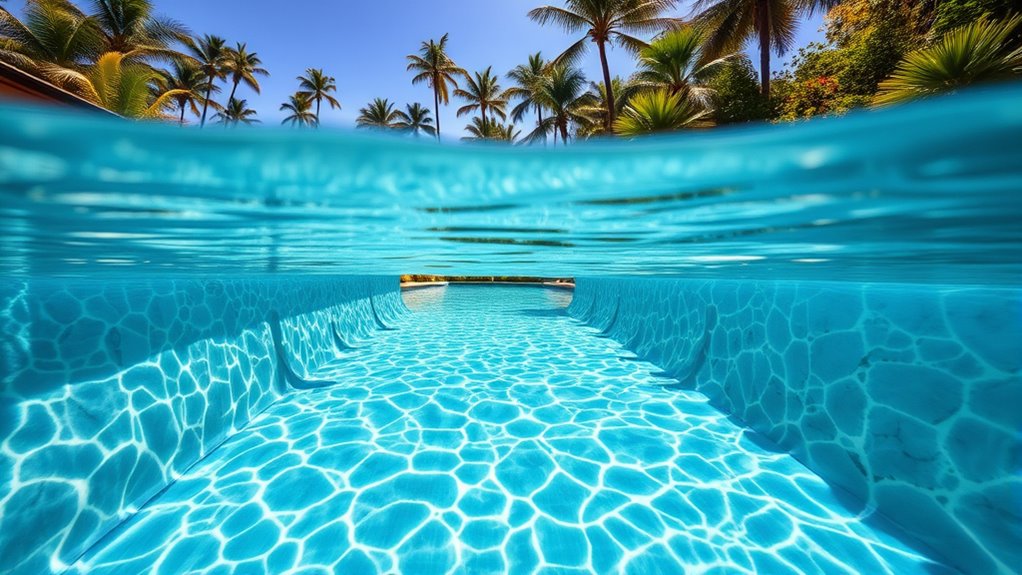
Maintaining water quality and effective filtration systems is indispensable for ensuring a safe and enjoyable lazy river experience. Clean water prevents bacteria, algae, and debris from building up, which can cause health issues or make the water unappealing. Your filtration system continuously circulates and filters the water, removing dirt and contaminants. Regular maintenance, including cleaning filters and monitoring chemical levels, keeps the water clear and balanced. Proper chlorination and pH control are crucial to prevent algae growth and ensure the water remains safe for swimmers. Without a reliable filtration system, water quality quickly deteriorates, leading to unpleasant odors and potential health hazards. Investing in a whole-house filtration system can provide comprehensive water treatment, ensuring consistent water quality throughout your lazy river. Prioritizing water quality and filtration not only enhances safety but also preserves the relaxing, pristine environment that makes your lazy river experience enjoyable.
Engineering Considerations for Safety and Comfort
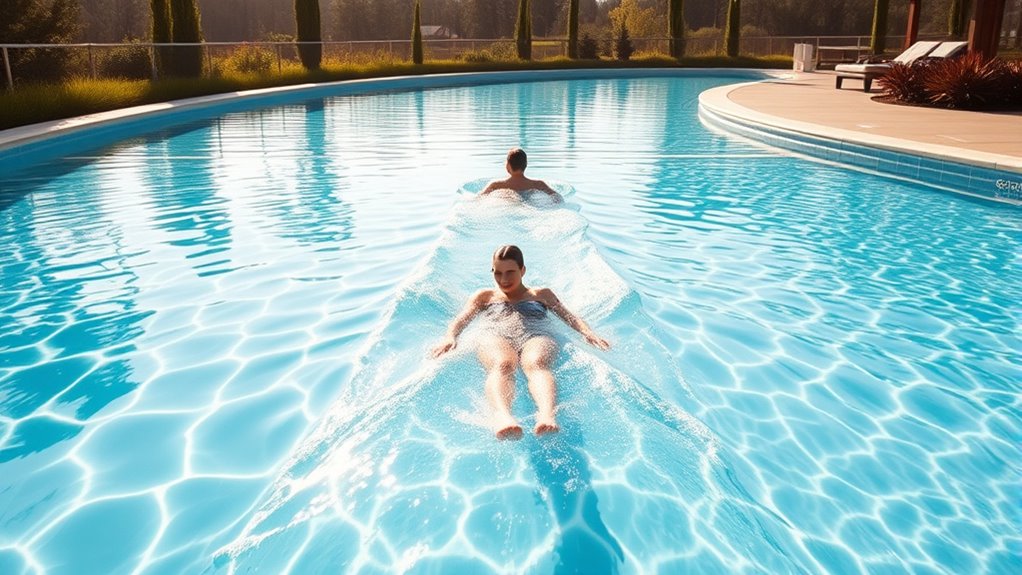
Engineering considerations play a crucial role in ensuring both safety and comfort in a lazy river pool. You need to focus on factors that protect swimmers and enhance their experience. Key elements include:
- Proper water flow design to prevent sudden currents or turbulence
- Adequate depth markings and gradual slopes for safe entry and exit
- Slip-resistant surfaces to reduce fall risks
- Clear signage and lighting for visibility and guidance
- Robust filtration and chemical systems to maintain water quality
- Regular maintenance and monitoring of water quality standards ensure the pool remains safe and inviting for users.
Innovations and Future Technologies in Lazy River Design
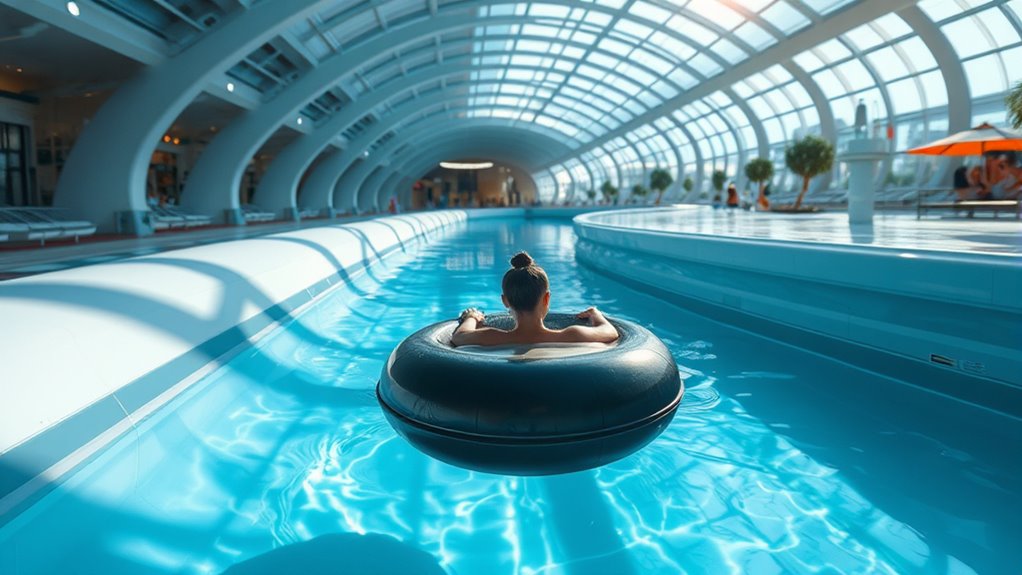
Innovations in lazy river design are transforming the way you experience these relaxing attractions, integrating smarter technology and sustainable practices. Modern systems now use energy-efficient pumps and variable speed motors to optimize water flow while reducing power consumption. Automated controls and sensors monitor water quality, ensuring safety without manual intervention. New materials, like eco-friendly liners, improve durability and minimize environmental impact. Some designs incorporate interactive features, such as LED lighting and sound effects, enhancing guest engagement. Advances in modular construction allow for easier customization and expansion of lazy rivers. Additionally, sustainable water management techniques, like rainwater harvesting and recycling systems, are making lazy rivers more eco-conscious. These innovations promise a more immersive, environmentally friendly, and seamless experience for visitors.
Common Challenges and Troubleshooting the System
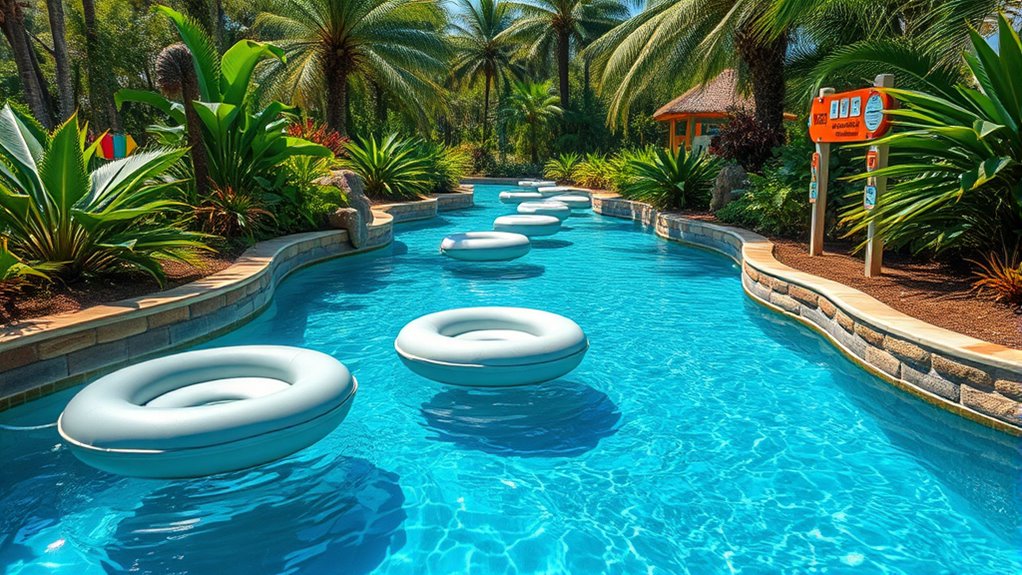
Despite advanced technology, lazy river systems can still encounter common issues that disrupt operation and guest experience. You might notice inconsistent flow, which can stem from clogged filters or debris blocking pumps. Sometimes, the water temperature fluctuates unexpectedly due to faulty thermostats or heating elements. Pump failures or irregular circulation can cause slowdowns or dead zones along the route. Leaks in the liner or piping may lead to water loss, affecting the entire system. Additionally, algae growth or cloudiness indicates poor water quality management. To troubleshoot, check and clean filters regularly, inspect pumps and heaters for faults, seal leaks promptly, and monitor water chemistry. Staying vigilant guarantees smooth operation and keeps guests safe and satisfied. Being aware of regional resources and tools can also aid in sourcing necessary replacement parts or expert assistance when needed.
Frequently Asked Questions
How Do Lazy Rivers Maintain Consistent Water Temperature?
They maintain consistent water temperature through a combination of heating and cooling systems, like heat exchangers or electric heaters, that regulate water as it circulates. You might not notice it, but sensors constantly monitor the temperature, triggering adjustments when needed. Pumps ensure continuous flow, preventing temperature fluctuations. This careful balance keeps the water comfortably warm or cool, so your lazy river experience remains relaxing and enjoyable every time you visit.
What Materials Are Best for Constructing Durable Flow Channels?
You should choose high-density, UV-resistant fiberglass or reinforced concrete for your flow channels—these materials are practically indestructible, handling endless water flow and weather chaos with ease. They resist cracking, erosion, and fading, ensuring your lazy river stays smooth and safe for years. Avoid cheap plastics or porous materials, which can degrade quickly and turn your relaxing drift into a bumpy nightmare. Durability is everything, so pick the best for your dream pool.
How Is Energy Efficiency Optimized in Lazy River Systems?
You can optimize energy efficiency in lazy river systems by using energy-efficient pumps that consume less power while maintaining flow. Incorporate variable speed controls to adjust flow based on demand and reduce unnecessary energy use. Properly insulate pipes to minimize heat loss and reduce the load on heating systems. Regular maintenance guarantees equipment runs smoothly, preventing energy waste. These steps help keep operational costs low and the system eco-friendly.
Can Lazy Rivers Be Customized for Different Themes and Aesthetics?
Yes, you can customize lazy rivers for different themes and aesthetics. You can choose unique materials, colors, and decorative elements like rocks, plants, or themed props to match your desired look. Additionally, the surrounding landscape and lighting can be tailored to create a specific ambiance. By working with designers, you can incorporate personalized features that enhance the visual appeal and make your lazy river truly one-of-a-kind.
What Safety Features Are Implemented to Prevent Accidents?
You’re protected by safety features like lifeguard stations, clear signage, and emergency stop buttons. Safety rails and non-slip surfaces keep you stable, while floatation devices are available if needed. The water flow is carefully regulated to prevent sudden currents, and barriers keep you within safe zones. Regular maintenance and staff training ensure the lazy river remains a safe, fun environment for everyone, giving you peace of mind while you relax.
Conclusion
Understanding the mechanics behind lazy river pools reveals they’re more than just floating along—they’re finely tuned marvels. With pumps, valves, and filtration working in harmony, you glide effortlessly through a carefully choreographed dance of water. Think of it as a well-orchestrated symphony, where each component plays its part to keep your drift smooth and invigorating. Next time you relax on a lazy river, remember, it’s a hidden marvel of engineering that makes your leisurely journey possible.

